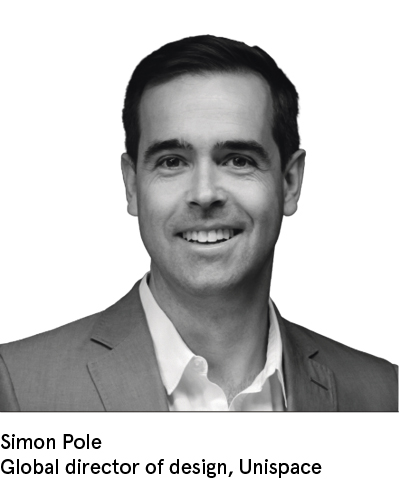 The pace of change in office design continues to accelerate. What’s clear is high-performance spaces that cater for a diverse workforce are now in demand.
The pace of change in office design continues to accelerate. What’s clear is high-performance spaces that cater for a diverse workforce are now in demand.
“We’re really starting to understand a lot more about people’s different needs in the working environment; it’s now a real science,” says Simon Pole, global director of design at Unispace, a workplace strategy, design and construction specialist agency.
“There’s so much data and we continue to collect a lot more, from surveys to sensors and beacons, so we know exactly how people use office space. The old adage applies: ‘What gets measured gets done.’ We want people to do their best at work.”
Demonstrating a causal relationship between workplace and productivity is the holy grail of business and many now realise it can be dependent on creating the optimal workspace. When looking at most companies on a Best Places to Work list, you will find their workplace is unique and tailored to achieve their business objectives and reinforce the company culture.
Workplaces are more successful when they’re built on evidence and experience. Pole says: “Our integrated strategy, design and delivery teams work hand in hand to use everything we already know, plus what we discover about our clients’ employees, industry and location, to transform the way people work and transform our clients’ business results. This essential strategy phase is so often left out of office design and construction, yet it’s crucial to getting the best return on investment.
We’re all different and we need different environments to achieve high performance
“Not that long ago very few employers talked about good design, now many realise performance can be boosted by innovative spaces. We all have different attributes that require differing work environments. Not only do we increasingly need a mosaic of spaces to get the best out of talent, we also need a variety of working conditions as well. Diversity is key.”
For instance, women generally prefer the office two degrees warmer than men. Baby boomers and the older generations need more light as their eyesight degrades. Extroverts excel in open environments designed for larger groups. Introverts generally enjoy smaller group spaces and the ability to seek solitude.
“Diversity and inclusion doesn’t just stop with the types of people you employ. It must be respected in the spaces we create for them too. All this needs considerate and thoughtful design. Diverse work styles cannot be expected to perform at their peak in a cookie-cutter environment,” says Pole, whose company works in 25 countries with tech firms, notably Facebook, professional services businesses such as PwC and Herbert Smith Freehills, through to bio-pharma giant Biogen and Boston Scientific, as well as the likes of Coca-Cola Amatil and Deliveroo.
“For the first time in history we have the diverse needs of four generations of workers within the office environment. At the same time, retaining talent has never been so important, while we increasingly expect more creativity and innovation from our workforce. The demands are high. The question we ask is: ‘Does your workspace work hard for you, releasing people’s energy, boosting creativity and productivity?’”
Different industries and jobs require different environments. Those in tech need spaces that foster high degrees of concentration, crucial for those buried in code on a regular basis, others require increased social environments. However, the types of tasks vary throughout a working day.
Distractions in the workplace vary across visual, acoustic, ergonomic, thermal or spatial. “Great workplace designers remove distractions to allow workers to be as effective as possible. This also involves creating optimal spaces for different types of working. Hot-desking isn’t necessarily right for everyone, some like assigned spaces. Completely open-plan offices aren’t always great for those who need to focus,” explains Pole.
A Unispace global study of professional service firms, involving more than 10,000 respondents, found that 61 per cent of time spent in the office involves individual focus, 24 per cent requires collaboration, while only 8 per cent is spent socialising and 7 per cent is learning time.
“Increasingly, we’re observing employees involved in ‘co-focus’, when they’re collaborating on focused work in open environments disturbing others around them. With this behaviour on the increase we must fit out spaces in a way that respects the type and diversity of tasks, focusing on flexibility. We’re all different and we need different environments to achieve high performance. It’s personal,” says Pole.
“At Unispace, we’ve also surveyed and benchmarked hundreds of offices around the world over the past ten years. We know what to look for and how to achieve a great result for our clients.”
Certainly, there needs to be some new thinking and articulation in this space. The productivity of UK workers fell at the fastest pace for five years in the second quarter of 2019. It was the worst performance since mid-2014. Economists believe improvements in productivity are crucial for boosting economic growth and raising living standards, especially in a post-Brexit world.
“While the workplace cannot solve the country’s productivity puzzle, it can assist with employee performance,” says Pole.
In addition, there are other factors office designers are looking at. For instance, fresh air flow can heighten brain function. Lighting levels and colour boost activity, as do views of nature. Unispace also looks at colour psychology, pattern theory and spatial psychology.
“We have an incredible number of tools in our armoury that can help the high-performance working environment. At the same time, organisations are starting to really thrive on diversity. Marry the two and we have an incredible potential to make a real difference. Don’t knowingly underestimate what can be achieved by fantastic workplace design,” Pole concludes.
Unispace has more than 700 staff in 46 studios around the world, focused on helping businesses create places where people do their best work.
For more information please visit www.unispace.com or follow Unispace and Simon Pole on LinkedIn
